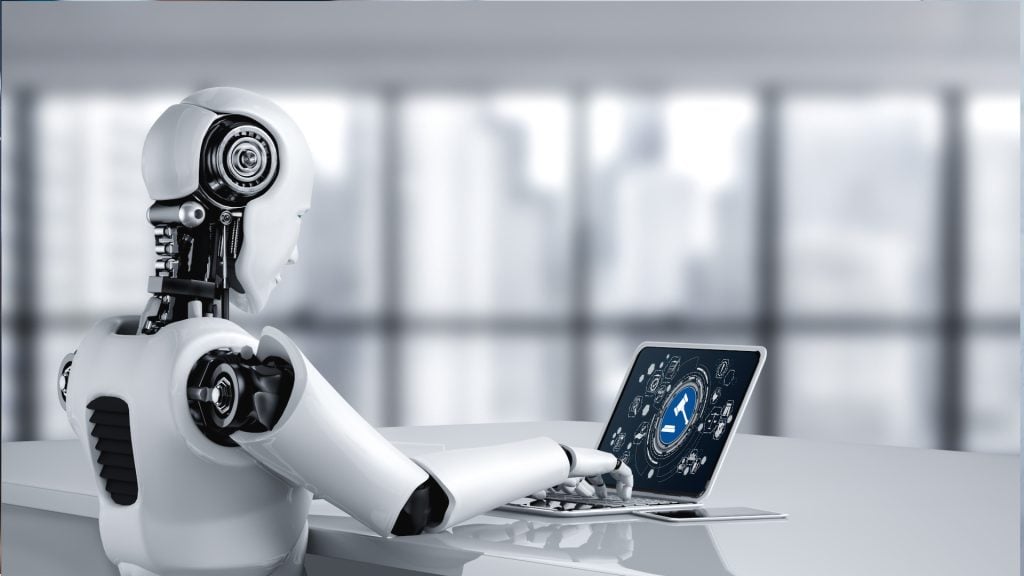Robots have been an integral part of the working world for decades. In industrial assembly, for example, “cobots” are on the move as driverless transport systems in logistics, stacking heavy boxes or welding workpieces together in production.
In business process management (BPM), they are increasingly assisting as small automated computer programs – known as “bots” for short. A new phase of industrialization is now emerging in which both haptic and virtual robots are no longer merely providing support, but are working together with humans as equals. Human-technology interaction, or “HumanTech” for short, is the name given to this fusion of human skills with artificial intelligence (AI) and robotics. It enables the automation of tasks that require human intelligence and a high degree of precision.
One of the first comprehensive analyses of the term human-tech was written by Carsten Röcker and Sebastian Büttner. In their specialist book “Human-Technology Interaction – Shaping the Future of Industrial User Interfaces”, published in December 2022, they examine the interplay between Industry 4.0 and the new interaction technologies based on selected research contributions on the topic of human-technology interaction. According to this, the increasingly close intelligent networking of people, machines and industrial processes could lead to a decisive paradigm shift. The intelligent machine of the future will no longer try to displace the human workforce, but will support it in working faster and more efficiently. This will not only fundamentally change the organization and workflows of familiar production and work processes, but also the meaning of work itself: human work will become more sustainable and more valuable – welcome to Industry 5.0.
The evolution of human-machine collaboration in BPM
What began decades ago as a simple automation process has evolved over time into an increasingly close partnership between humans and machines.
In business process management (BPM), for example, human activities have long been combined with robot-controlled automation processes (RPA), in which software robots – “bots” for short – take on user roles and interact independently with other software systems across system boundaries.
The bots in these “human-centric workflows” are equipped with a comparatively high level of cognitive, sometimes creative skills and relieve employees of tedious, repetitive “compulsory exercises” such as entering supplier data into an ERP system, copying and pasting data into Excel or repeatedly reading data from a website.
Robots generally work many times faster than humans and are not bound by time constraints.
They don’t need breaks or vacations, they don’t get tired and they tirelessly perform even monotonous tasks with consistently high precision.
Employees can now use the time gained in this way for value-adding activities and prepare strategically important contract negotiations, for example.
In addition to digital bots, BPM relies on other key components such as artificial intelligence and machine learning or so-called extended human interfaces in its HumanTech applications.
This multidisciplinary approach, in which the technologies support each other, enables constant interaction between humans and machines for the execution of a variety of tasks.
There are no limits to the areas of application.
Whether in controlling, customer service, risk management, HR or marketing: robots are all-rounders and also highly adaptive.
A new level of efficiency through AI-based process management
The mass of data that needs to be processed in the age of digital transformation is presenting companies with ever greater challenges. AI systems are becoming increasingly helpful to process managers. For example, they prepare suggestions for typical process flows and risks in advance, analyze large amounts of data in real time or examine process flows for bottlenecks and sources of error. AI also evaluates historical data on the course and results of processes, recognizes uniform patterns and uses these to make predictions. This enables companies to identify bottlenecks at an early stage and react immediately to changes in the market and demand by adapting their processes. AI-based process management not only increases the efficiency and profitability of processes, it also supports companies in achieving a completely new level of optimization and automation towards true process excellence: Previously unnoticed potential is recognized and exploited, companies work more efficiently and therefore more profitably.
Human-machine interaction as an optimization factor
At a time when it is becoming increasingly difficult to make machine performance even faster and more efficient, the interaction between man and machine is also becoming a key optimization factor that can help companies remain competitive. Communication interfaces between man and machine therefore play a decisive role in HumanTech. Functions such as speech recognition, gesture control or haptic feedback can make interaction more natural and, above all, more efficient. Advanced algorithms enable machines to understand human language and interact with employees in a natural and efficient way, even without physical input devices. Gesture control helps with the contactless control of machines using hand movements or finger points. Cameras or sensors capture the gestures and translate them into commands, which is particularly advantageous in environments such as production or medicine. Haptic feedback through artificially generated touch or pressure sensations allows machines to efficiently and safely provide users with information about the status of actions or processes.
Digital bots in BPM use various technical functions to increase the efficiency of processes and work as assistance systems alongside humans to discover and initiate optimizations. BPM serves as the tool in the background. It paves the way into the digital world and enables proactive process management, allowing companies to anticipate emerging problems at an early stage and take measures to continuously improve their processes.
A new era of cooperation
HumanTech is only at the beginning of its development and there are still a number of challenges and ethical considerations that need to be taken into account. Questions about data protection, for example, the security of AI systems or the impact on workplaces and social structures. An even more comprehensive integration of HumanTech into process management or into other areas and industries will definitely drive innovation and lead to even more profound changes. In the long term, the seamless cooperation of humans, AI and robotics can revolutionize the way we work and collaborate and shape a completely new era of collaboration.

















